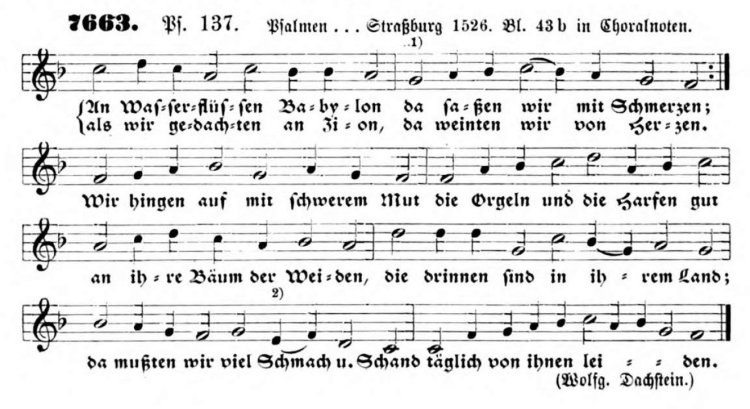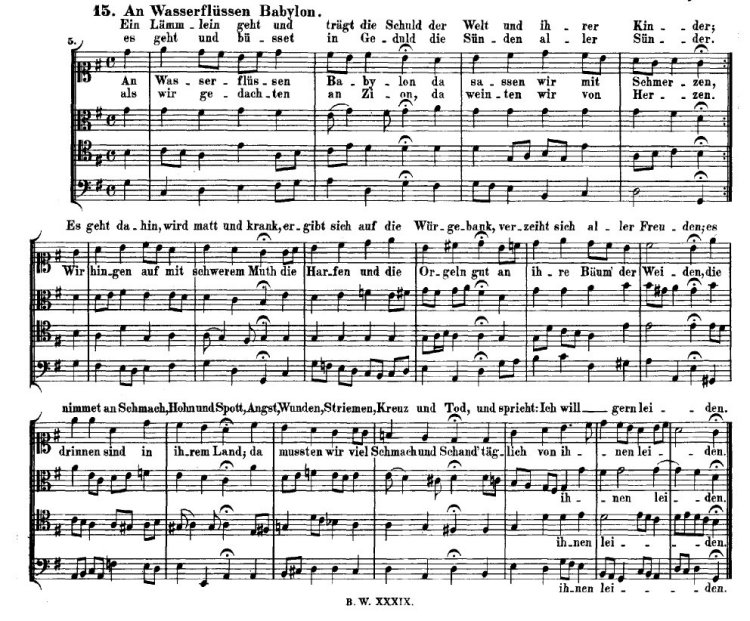|
Chorale Melodies used in Bach's Vocal Works
An Wasserflüssen Babylon |
|
Melody & Text | Use of the CM by Bach | Use of the CM by other composers |
| |
|
Melody & Text: |
|
The hymn and melody appeared together in the third part of the Teutsch Kirchēamt mit lobgsengen (Strasbourg, 1525). The words are by Wolfgang Dachstein, to whom the melody also is assigned. He was Organist of Strasbourg Cathedral, and later, having become a Protestant, of St Thomas’ Church there. He died circa 1561.
Source: Charles Sanford Terry: Johann Sebastian Bach, Bach’s Chorals, vol. 3 The Hymns and Hymn Melodies of the Organ Works (1921), pp 94-97 |
|
Melody: Zahn 7663
Composer: Matthias Greiter (not Wolfgang Dachstein) (1525) |

 |
|
Text 1: An Wasserflüssen Babylon
Author: Wolfgang Dachstein (1525) |
|
Text 2: Ein Lämmlein geht trägt die Schuld
Author: Paul Gerhardt (1647) |
| |
| |
|
Use of the Chorale Melody by Bach: |
|
There are two movements upon the melody in the Organ works - in the Eighteen Chorals and among the miscellaneous movements (Fünfstimmig). Griepenkerl states that Krebs’ copies of the two are marked respectively “Vers 2” and “Vers 1.” They display a close relation in tonality, atmosphere, and construction. Both are in G major. Both are inspired by the word “Wasserflüssen” (waves). In quavers, against the crotchets of the cantus, the accompaniment ripples on pellucidly in a figure which, in No. 18 especially, is reminiscent of Schubert’s familiar “Barcarolle.” Though No. 17 is six bars longer than No. 18, the two movements are otherwise similar. Practically they are built upon the same Bass, and their contrapuntal accompaniment to the cantus is constructed out of the opening two lines of the melody. In No. 17 the close is prolonged upon a final (tenth) statement of the opening phrase of the cantus. The melody also occurs in Choralgesange, No. 23. In the penultimate bar (supra) E flat for E natural as the sixth note was general after 1653. Witt (No. 601) has it and also J.S. Bach’s B natural as the penultimate note of bar 4 supra. Of J.S. Bach’s B natural as the third note of bars 2 and 4 Zahn (No. 7663) affords no earlier example.
Source: Charles Sanford Terry: Johann Sebastian Bach, Bach’s Chorals, vol. 3 The Hymns and Hymn Melodies of the Organ Works (1921), pp 94-97 |
|
Text 1: An Wasserflüssen Babylon |
|
Text 2: Ein Lämmlein geht trägt die Schuld |
|
Chorale An Wasserflüssen Babylon / Ein Lämmlein geht trägt die Schuld, BWV 267
An Wasserflüssen Babylon (1525) (Heading given for Breitkopf chorale No. 5)
Ein Lämmlein geht trägt die Schuld (1647) (Heading given for Breitkopf chorale No. 308)
Ref: RE 5=309 (R5 down a m2) (see note below); Br 5=308 (B5 down a m2) (see note below); Di 144; Birnstiel 5 (down a m2); AmB 46II p.76, p.99, p.156 & p.332 (pp.99 & 156 down a m2); Levy–Mendelssohn 25; Fasch p.68 (down a m2); KE 23; BGA; BC F17.1 |
|
This chorale survives without text. The first text provided here follows the heading given for Chorale No.5 in the Breitkopf collection, and the second text follows the heading given for Chorale No.308, a duplicate appearance of the setting.
This setting appears multiple times in both the Breitkopf–Riemenschneider collection (twice) and the AmB 46II manuscript (4 times). Likely reasons for the duplication of settings in these early collections include different headings given for identical settings and settings being presented in two different keys that are otherwise identical. In the case of this setting, both are involved. The two different headings provided for this setting are "An Wasserflüssen Babylon" and "Ein Lämmlein geht trägt die Schuld." The setting also appears in the keys of G major and A–flat major. Curiously, there is no consistent correlation between headings and keys.
Dietel: A–flat major — "Wasserflüssen"
Br 5–RE 5: G major — "Wasserflüssen"
Br 308–RE 309: A–flat major — " Lämmlein"
AmB 46II p.76: A–flat major — "Lämmlein"
AmB 46II p.99: G major — "Wasserflüssen"
AmB 46II p.156: G major — "Wasserflüssen"
AmB 46II p.332: A–flat major — "Wasserflüssen"
Fasch p.68: G major — "Wasserflüssen"
levy–Mendelssohn 25: G major — "Wasserflüssen"
Preference is given here to the Dietel collection due to its early date and to the liklihood that Dietel copied directly from J.S. Bach’s original manuscripts. Thus, the setting is presented here in A–flat major.
Source: bach-chorales.com by Luke Dahn (2018) |
 |
|
Untexted: |
|
N. xvii. 18. The movement is No. 3 of the Eighteen Chorals. Schweitzer1 finds in it the evident influence of Georg Böhm, Organist of St John’s Church, Lüneburg, from 1698 to his death in 1734 (?). Philipp Spitta, on the other hand, detects in it the example of Dietrich Buxtehude (1637-1707), Organist of St Mary’s Church, Lübeck, but concurs with Schweitzer in regarding the movement as an early essay of J.S. Bach’s. He dates its composition circa 1712, during the Weimar period.
No. 17 is not the oldest form of the movement. B.G. xxv. (2) 157 (P. vi. 103) prints an older version of it which may be distinguished as No. 17a. In the year 1720, as will be shown, J.S. Bach revised No. 17a and produced No. 18. No. 17 seems to have been the final text, prepared for the collection upon which J.S. Bach was at work at the time of his death. With what art he creates (cf. No. 18 where the impression is less evident) an atmosphere of languor congruous to stanza i of the hymn!
N. xviii. 13 was the result of a revision of No. 17a, whose occasion P. Spitta suggests with plausibility. In the autumn of 1720 J.S. Bach visited Hamburg, where the post of Organist in the Church of St James was vacant. Johann Adam Reincken, the veteran Organist of St Catherine’s Church there, came to hear J.S. Bach play, and complimented him upon an improvisation, in the broad Bohm-Buxtehude manner, upon the melody “An Wasserflüssen Babylon,” a theme which J.A. Reincken himself had treated in a Prelude. P. Spitta suggests that J.S. Bach revised the Hamburg improvisation (No. 17a) and sent J.A. Reincken No. 18. Having regard to J.A. Reincken’s age and traditions it was natural that J.S. Bach should offer him a composition in the manner of G. Böhm (J.A. Reincken’s pupil) and Buxtehude rather than in the new forms J.S. Bach was originating. While preserving the framework of No. 17a, J.S. Bach added a second Pedal part, an addition which entailed removing the cantus from the Tenor, where it lies in Nos. 17a and 17, to the Treble.
The single ms. of No. 18 is in the Royal Library, Berlin, inscribed “J.S.B.” by Krebs.
Source: Charles StanfoTerry: Johann Sebastian Bach, Bach’s Chorals, vol. 3 The Hymns and Hymn Melodies of the Organ Works (1921), pp 94-97 |
|
Chorale Prelude An Wasserflüssen Babylon (I), BWV 653 |
| |
|
Chorale Prelude An Wasserflüssen Babylon (II), BWV 653a |
| |
|
Chorale Prelude An Wasserflüssen Babylon (III), BWV 653b |
| |
| |
|
Use of the Chorale Melody by other composers: |
| |
| |
|
Sources: Bach Digital; BGA; Zahn
Photos from Gottfried Vopelius Neu Leipziger Gesangbuch (Vopelius 1682), were taken from a digital copy of the book downloaded from Bayerische Staatsbibliothek. This copy is Out of copyright - non commercial re-use (Europeana Rights).
Prepared by Aryeh Oron (October 2018) |